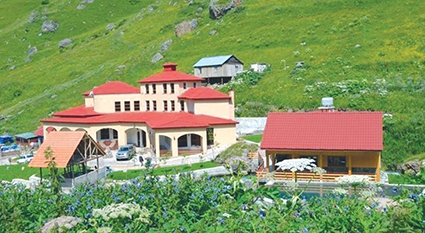Is Tourism in Georgia a Threat to Rural Life?
Soaring peaks and unique cave towns, endless green valleys and ancient watchtowers. Georgia’s unique rural life and scenery are attracting more and more international visitors by the year. The Georgian National Tourism Administration announced that more than 8 million people visited Georgia between January and November this year, an increase of 10.6% compared to the same period in 2017. With many of the visitors flocking to Georgia’s rural areas, could this increase in numbers threaten rural life?
My driver pulls sharply on the steering wheel as the contents of his car, myself included, are flung to the left. Darkness makes it impossible to see why he has swerved. Probably a cow, I think to myself. “Sorry, the road is so bad, better to go on the field,” he assures me, noticing my concern.
Those who have visited the farther-flung corners of Georgia will be acquainted with nail-biting journeys on narrow roads in terrible condition. The need for improved infrastructure is obvious and progress has been slow. Nonetheless, investment is slowly trickling into the infrastructure of rural areas, largely due to the increased number of visitors, making local mobility easier.
Yet it seems little regard is paid to the potential destruction of the wild landscapes as new roads are built. Works on a road leading from Stepandtsminda to Gergeti Trinity Church were recently completed, enabling tourists to reach the church by car. During the works, the once green foothills of Kazbegi were turned into a mud bath of tracks and dirt, tarnishing the view at the top. Some question the necessity of the road at all, as the church was already easily accessible after a short hike, and an old cable car, already built, could have been restored and monetized.
An increase in tourism to natural areas can always threaten its natural beauty. Hotels and guest houses are rapidly being built in villages where, a few years ago, there was very little. As is typical in Georgia, many of these buildings are unregulated. Juta, a small village at the start of the Chauki Pass, had very few visitors a few years ago. Now, guests are greeted with the stark signs of ‘Sauna”, ‘Guesthouse’, and ‘beer, vodka, wine.’ Although amenities in the village are wanted, it cannot be said that the new constructions blend into the surrounding countryside.
Walking from Juta towards the Chauki Pass, a campsite set up at the base of the jagged peaks caters to tourists in summer. Plastic bags and rubbish are sprawled across the grass whilst horses graze in the makeshift shelters.
These businesses represent the entrepreneurship of the local residents who are harnessing the monetary potential of incoming tourists. Rural areas in Georgia have struggled with climate change and poverty in recent years. After the collapse of the Soviet Union, many countryside residents moved to bigger towns in search of a better way of life. The influx of tourism is helping to sustain the economy in rural areas, boost the income of struggling farmers, and offer new forms of employment.
However, many neighbors are now not only the family who live next door, but business competitors. While earlier struggles helped solidify a sense of community, responsibility for each other, and a shared identity, competition is beginning to challenge this community spirit. Neighbors compete to offer tourists the lowest prices, most ‘authentic’ taste of Georgian life, standards of comfort, and food.
If tourism in Georgia’s rural areas is correctly managed and developed, it offers a huge opportunity for locals to improve their quality of life. The modernization of roads and economic potential will greatly ease the hardship of traditional life. Nonetheless, it remains unclear whether these projects will be done with the most important factor in mind: the preservation of the beauty of Georgia’s wilderness and traditions.
By Amy Jones












